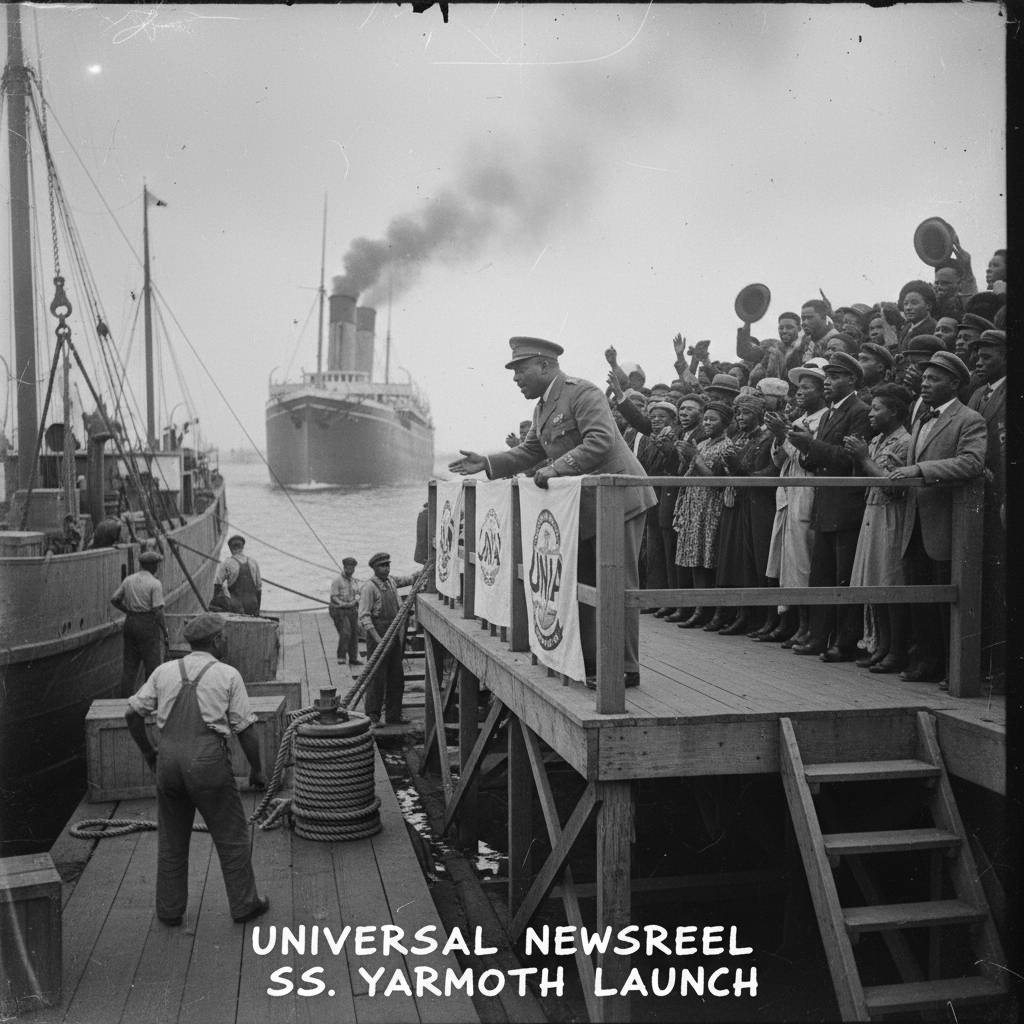Pride, Ships, and Pan-African Dreams
The launch of the SS Yarmouth turned the Black Star Line from an idea into a living engine of Black economic pride.
 The SS Yarmouth became the beating heart of a global dream: Black ownership on the open sea.
The SS Yarmouth became the beating heart of a global dream: Black ownership on the open sea.When the SS Yarmouth pulled into service under the banner of the Black Star Line, something shifted in the hearts of millions. Before the Yarmouth, Garvey’s talk of a Black-owned fleet sounded like bold prophecy. After the Yarmouth, it sounded like tomorrow.
This ship was not sleek, new, or blessed by bankers. She was old, imperfect, and frequently doubted by maritime insiders. But to Garvey’s followers, she was sacred. Not because of what she was — but because of what she meant.
- How the SS Yarmouth was purchased, refitted, and launched.
- Why this vessel became the emotional core of the Black Star Line.
- The symbolism of the first voyage for the global African diaspora.
- How the ship’s successes and struggles shaped Garvey’s movement.
Why the SS Yarmouth Mattered
In a world where Black people were expected to shovel coal in someone else’s boiler room, the idea of a ship flying a Black-owned flag felt impossible. Garvey set out to make the impossible routine.
“The Yarmouth was more than steel and rivets — it was a chapter in our self-respect.” — Reggae Dread Archives
When the ship was unveiled in 1919, newspapers mocked the venture. Investors in white-owned companies scoffed. Bankers refused credit. Yet at Liberty Hall, people cheered until their voices shattered.
- Black ownership in an industry designed to exclude them
- A tangible symbol of global unity
- A classroom for learning maritime skills
- A rebuke to white supremacist assumptions about competence
Buying the Yarmouth: A Bold, Risky Leap
The Yarmouth was not the ideal ship on the market. She was aging, built in the late 19th century, and had seen decades of service. But she was affordable — just barely within range of the funds Garvey and the UNIA raised from ordinary people.
Unlike white corporations backed by banks, Garvey had to crowdsource capital from hairdressers, stevedores, preachers, restaurant cooks, and seamstresses. Every dollar was a sacrifice.
"Black people didn’t buy a ship; they bought a future."
After inspection and negotiations that bordered on the miraculous, the Yarmouth was purchased. Members celebrated as though they had acquired a continent.
Refitting the Ship: Sweat, Hope, and Urgency
Once purchased, the Yarmouth needed immediate repairs. Garvey’s team brought in mechanics, painters, and volunteer labor. Crews worked long hours in shipyards, transforming an aging steamer into a vessel that looked worthy of a nation-in-the-making.
- Hull scraped and repainted
- Engine repairs and updates
- Interior bunks refurbished
- UNIA banners sewn and mounted
When the final coat of paint dried, the ship stood reborn — not as new steel, but as new spirit.
Launch Day: A Parade on Water
When the SS Yarmouth was officially launched, Harlem erupted. Tens of thousands flocked to the piers. Brass bands played. Women waved flags. Children climbed lamp posts for a glimpse of the ship sailing under the Black Star Line banner.

“When she pulled away from the dock, we felt ten feet tall.” — UNIA Elder Testimony
Garvey stood at the bow, saluting the crowds. In that moment, the ship became something larger than wood and iron. It became a mirror in which Black people saw dignity.
The Yarmouth’s Routes: Diaspora Corridors Reconnected
The ship sailed crucial routes linking Black communities:
- New York → Havana
- New York → Kingston
- Kingston → Panama Canal Zone
- Return routes carrying goods, produce, and passengers
Each voyage wasn’t just a commercial trip — it was a declaration that distance no longer equaled separation.
The Deep Symbolism of the SS Yarmouth
The most powerful effects of the Yarmouth were symbolic:
- Proof that Black capital could acquire global assets
- Evidence that unity could overcome structural racism
- Inspiration for future African independence leaders
- Psychological liberation in maritime form
“A people who once crossed the ocean in chains now owned a ship that sailed by choice.” — Reggae Dread Reflection
The Challenges Beneath the Glory
The Yarmouth, for all its pride, faced serious issues:
- Ageing machinery prone to breakdown
- Limited funds for repairs
- Sabotage and scrutiny from rivals
- Insurance discrimination
These challenges foreshadowed later struggles for the Black Star Line — but at the height of the Yarmouth’s voyages, the movement still burned bright.
The Cultural Ripple: Music, Identity, and Diaspora Pride
The Yarmouth entered poetry, sermons, parades, and eventually reggae lyrics. It became an emblem of the Garveyite imagination.
Later Rastafari elders recalled the Yarmouth as proof that Garvey’s teachings weren’t just talk — they were action.
“The Yarmouth sail through history like a rhythm — steady, rebellious, unstoppable.” — Reggae Dread Commentary
Legacy of the SS Yarmouth
Even after the Yarmouth was retired, her legacy lived on:
- She inspired future diaspora-owned shipping ventures.
- She anchored Garveyism in physical reality.
- She became a symbol of what is possible with unity.
- She influenced independence movements in Africa and the Caribbean.
Conclusion: A Ship That Became a Signal Fire
The SS Yarmouth was imperfect, battered, and often underestimated. But in Garvey’s hands, she became a torch — a living flame waving across the Atlantic, telling the world:
“We can build. We can buy. We can lead.”
Her influence reaches into the present. Every Black-owned logistics firm, every diaspora investment initiative, every Pan-African conference — they all sail in the wake of the Yarmouth.
The ship may be gone, but the dream she carried remains unsinkable.
Continue the Marcus Garvey in New York (1916–1924) Series:



























